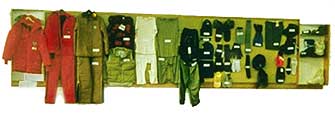
The
Inside Story
|
|

|
|
|
A
display of cold-weather gear at McMurdo Station
©NSF
|

|
|
by
Paul Doherty
November
29, 2001
It
can be very cold in the Antarctic. It is also often windy.
The combination can cause a person to become frostbitten or
hypothermic.
Modern
cold-weather gear has greatly improved the safety and comfort
of people living and working in the cold.
Here
are some items of clothing we'll wear in the Antarctic that
were not available to the original Antarctic explorers.
The
Upsides of Down
Down--the fine, insulating underfeathers of waterbirds--provides
lightweight loft in clothing. But the real insulation is provided
by the air trapped in down's fine structure. Stationary air
is a terrible heat conductor--which is another way of saying
it's a good insulator. Down clothing can provide inches of
insulation without adding too much weight. Actually, steel
wool would work nearly as well as down, but would be far too
heavy.
There
are several different ways to encase down between clothing
layers. One way is to sew the layers together like a quilt.
Called "sewn-through" clothing, this method can
leave unwanted cold spots. You can also maintain the thickness
by sewing cloth baffles between inner and outer cloth layers.
(Good down sleeping bags use baffles.) This is a more expensive
construction technique, but is considerably warmer than sewn-through
quilting.
Down
does not provide good insulation when it gets wet, but this
should not be a problem at the South Pole or in the Dry Valleys,
where it hasn't rained in millions of years.
|

